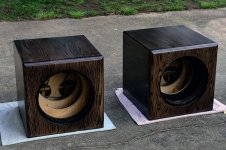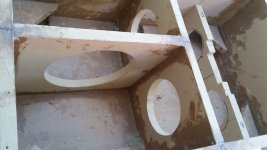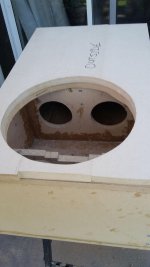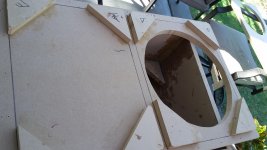Hi all,
Today I finished a subwoofer for my car using the Scanspeak 30W/4558T and 30W/0-00 in a 70.8 litre (2.5 cubic foot) enclosure. The box uses 19mm MDF and is heavily braced, I made allowance in the box volume for the bracing, sub and passive radiator displacement and I covered the walls in 25mm convoluted foam. The amplifier is a 600 watt Class D that is very clean and well behaved, I have the input sensitivity turned well down.
The result is less than good, the bass is tubby, one noty and the the sub seems to overload at even low volume. I haven't measured it yet but I can not live with it as is. Would anyone care to hazard a guess as to what I might have done wrong or what is going on here?
Thanks.
Today I finished a subwoofer for my car using the Scanspeak 30W/4558T and 30W/0-00 in a 70.8 litre (2.5 cubic foot) enclosure. The box uses 19mm MDF and is heavily braced, I made allowance in the box volume for the bracing, sub and passive radiator displacement and I covered the walls in 25mm convoluted foam. The amplifier is a 600 watt Class D that is very clean and well behaved, I have the input sensitivity turned well down.
The result is less than good, the bass is tubby, one noty and the the sub seems to overload at even low volume. I haven't measured it yet but I can not live with it as is. Would anyone care to hazard a guess as to what I might have done wrong or what is going on here?
Thanks.
Hi!
I tested the small brother 26W/4558T00 (same motor but smaller cone, 60l vented and closed box) in a car, that was one of the worst sound experience I have met. One note, loose, powerless bass that causes real headache in few minutes of listening music, and yes the driver moved a lot but my feet didn't.
I created that speaker for home listening primarily but I sold the drivers because I didn't liked in the living room either, although was not as bad as in car.
I tested the small brother 26W/4558T00 (same motor but smaller cone, 60l vented and closed box) in a car, that was one of the worst sound experience I have met. One note, loose, powerless bass that causes real headache in few minutes of listening music, and yes the driver moved a lot but my feet didn't.
I created that speaker for home listening primarily but I sold the drivers because I didn't liked in the living room either, although was not as bad as in car.
Last edited:
Greets!
With a 17 Hz driver in a small cab tuned to 9.5 Hz, it's well below a normal vehicle's tuning, so guessing this + maybe a peaking at Fs is the 'tubby'/'one note' you're experiencing. At this point, assuming you're sure there's no air leaks it seems better to remove the PR and seal up the cab.
GM
With a 17 Hz driver in a small cab tuned to 9.5 Hz, it's well below a normal vehicle's tuning, so guessing this + maybe a peaking at Fs is the 'tubby'/'one note' you're experiencing. At this point, assuming you're sure there's no air leaks it seems better to remove the PR and seal up the cab.
GM
Thanks for the replies.
YSDR, I have to disagree about the sound quality of the Scan Discovery subs. I've heard the 30W/4558T in a small sealed box and it was very nice. I am looking for extension on the low end so I tried the passive.
GM, thanks for the info. Scanspeak recommends 67 lites (2.36 cubic feet) sealed and I don't know if they are allowing for driver displacement and bracing bit I'll try to work it out.
How much bracing is needed in a sealed enclosure compared to a ported one?
YSDR, I have to disagree about the sound quality of the Scan Discovery subs. I've heard the 30W/4558T in a small sealed box and it was very nice. I am looking for extension on the low end so I tried the passive.
GM, thanks for the info. Scanspeak recommends 67 lites (2.36 cubic feet) sealed and I don't know if they are allowing for driver displacement and bracing bit I'll try to work it out.
How much bracing is needed in a sealed enclosure compared to a ported one?
Depends on what we mean on sound quality. Harmonic distortion maybe low, and I am sure some EQ would helped a lot about the one-note bass. Did you measured the in-car response?
I agree. Measure then EQ. There is a good chance that your box is too large for a car application. Cabin gain happens at relatively higher frequency compared to room gain, so you can't simply go with a design that looks good for home use in a car.
Depends on what we mean on sound quality. Harmonic distortion maybe low, and I am sure some EQ would helped a lot about the one-note bass. Did you measured the in-car response?
I used a Speak Revelator 28W/4878T00 in a 1.3 cubic feet sealed enclosure and learned, or was told, a couple things in the process. One, at least from the installer that put the system in, car enclosures tend to be a bit smaller. While Madisound recommends a 1.5 for a home system sealed, my installer would have preferred closer to 1 cu. ft.
Two, Cabin gain is significant; for the 28W in a larger room it would be 3dB down at 45Hz, in my car it is much lower. A simulated 6dB room gain response has it rolling off at 19Hz.
I am very happy with the sound. I need to get it to the installer again to tweak the tuning. Not that I think it is bad, just that there is a firmware update for my DSP and I want to tweak my 2-seat tune a bit.
Some reason this link takes me to the bottom of the page, just scroll up.
Enclosure design for X5/X6 storage compartment | Page 2 | DiyMobileAudio.com Car Stereo Forum
Two, Cabin gain is significant; for the 28W in a larger room it would be 3dB down at 45Hz, in my car it is much lower. A simulated 6dB room gain response has it rolling off at 19Hz.
I am very happy with the sound. I need to get it to the installer again to tweak the tuning. Not that I think it is bad, just that there is a firmware update for my DSP and I want to tweak my 2-seat tune a bit.
Some reason this link takes me to the bottom of the page, just scroll up.
Enclosure design for X5/X6 storage compartment | Page 2 | DiyMobileAudio.com Car Stereo Forum
Last edited:
Thanks for all the replies, all good information.
Scanspeak recommends a 67 litre (2.36 cubic feet) box for sealed which equals -3db at 34Hz, this is for a home subwoofer. Am I correct in assuming that because of cabin gain this would not work in my car? I have room in the car for a box this large.
Also, what type of bracing and damping do I need in a sealed enclosure?
Scanspeak recommends a 67 litre (2.36 cubic feet) box for sealed which equals -3db at 34Hz, this is for a home subwoofer. Am I correct in assuming that because of cabin gain this would not work in my car? I have room in the car for a box this large.
Also, what type of bracing and damping do I need in a sealed enclosure?
Thanks for all the replies, all good information.
Scanspeak recommends a 67 litre (2.36 cubic feet) box for sealed which equals -3db at 34Hz, this is for a home subwoofer. Am I correct in assuming that because of cabin gain this would not work in my car? I have room in the car for a box this large.
Also, what type of bracing and damping do I need in a sealed enclosure?
According to Madisound;
Suggested box alignments:
One cubic foot sealed for use in autosound systems.
One cubic foot sealed with a plate amp and boost for use in home systems. With our KG5230 the F3 would be 38Hz.
The 30W/4558T and the 30W/0-00 passive radiator in a 2.5 cubic foot box should be 3dB down at 30Hz.
For a vented box of 2.5 cubic feet, 3" vent by 11" long, your F3 is 27Hz.
GM, thanks for the info. Scanspeak recommends 67 lites (2.36 cubic feet) sealed and I don't know if they are allowing for driver displacement and bracing bit I'll try to work it out.
How much bracing is needed in a sealed enclosure compared to a ported one?
You're welcome!
Sealed is very flexible in that Qts', Qtc' can be pretty far off and still sound good due to our falling hearing acuity below ~500 Hz, hence one reason the recommendation to go smaller than traditional sealed theory dictates, so with a ~0.64 Qtc' this most likely is for a HIFI/HT app since its Fc is in the low 30s whereas a mobile audio's longest cabin dimension is typically much higher, ergo needs a higher Fc to ~match it: ~SoS/F
Qts' = Qts + any added series resistance [Rs]: HiFi Loudspeaker Design
Same-same, i.e. we don't want it to 'breathe', so all six sides tied together and ideally the driver's motor brace is an integral part of it with its frame only tightened enough to seal, not truly support, it: 6moons audio reviews: Stephæn's Altec 604 Dream Speaker
GM
This driver is best in a 50 to 60L sealed sub i think, not a ported or with a passive radiator.
So your box is not fit for this driver. That's why it sounds tha bad. Not because the driver is bad.
So your box is not fit for this driver. That's why it sounds tha bad. Not because the driver is bad.
I used a Speak Revelator 28W/4878T00 in a 1.3 cubic feet sealed enclosure and learned, or was told, a couple things in the process. One, at least from the installer that put the system in, car enclosures tend to be a bit smaller. While Madisound recommends a 1.5 for a home system sealed, my installer would have preferred closer to 1 cu. ft.
Two, Cabin gain is significant; for the 28W in a larger room it would be 3dB down at 45Hz, in my car it is much lower. A simulated 6dB room gain response has it rolling off at 19Hz.
I am very happy with the sound. I need to get it to the installer again to tweak the tuning. Not that I think it is bad, just that there is a firmware update for my DSP and I want to tweak my 2-seat tune a bit.
Some reason this link takes me to the bottom of the page, just scroll up.
Enclosure design for X5/X6 storage compartment | Page 2 | DiyMobileAudio.com Car Stereo Forum
Thanks for the link. I followed your subwoofer build log and I am also a believer of using baltic birch mixed with MDF. Yesterday I bought MDF for a new sub enclosure which I will build tomorrow (Saturday). I have a quarter sheet of 18mm bb which I will include in the build.
As others have hit upon here cabin gain is significant inside a car, assuming you've got the windows closed. Car subwoofers tend to be designed with this in mind and often come with a much higher fs than home subwoofers. They are intended to be used in small sealed cabinets that roll off pretty high in frequency and require the cabin gain to EQ the response into giving you the low bass.
If you used a 70l box with that passive radiator it actually optimises extremely well into a box that would suit lots of rooms. That is rooms in a house.

You'll get a response above. This has a lot of low extension. It's actually a very nice design for a house. It uses a lower than 'optimum' tuning to give more low bass capability but then needs the room to compensate a little and provides you with more absolute extension than a maximally flat design.
The only reason why this would sound bad in a car is because with cabin gain you're getting way too much bass. This is not a peaky design by any step of the imagination, in fact it's the opposite, so that's not it. If you have DSP then a simple high pass filter should cut back the bass to where you need it to be.
If you don't have access to DSP then the easiest thing you can do is attach a 1kg weight to the passive radiator. This will lower the tuning frequency and give you a reduction in the low bass.

Is what you'll end up with. This should work better but it's still going to be too much bass for most cars.
The passive radiator box is a solid design. Using it in combination with DSP should sound excellent.
As a starting point if you can apply a 2nd order high pass filter with a Q of 0.3 and a frequency of 30Hz. If this has too much bass lower the Q, or raise the Q if you've got too little bass. Changing the Q between 0.2 and 0.4 will allow you considerable freedom in tuning how much bass you've got.
Alternatively if all you can do is apply stock high pass filters, such as a 2nd order Linkwitz, try applying a 2nd order LW at 50Hz.
Also, it's worth mentioning because anyone can make this mistake, but ensure you've got the subwoofers polarity correct with the mains.
If you used a 70l box with that passive radiator it actually optimises extremely well into a box that would suit lots of rooms. That is rooms in a house.
You'll get a response above. This has a lot of low extension. It's actually a very nice design for a house. It uses a lower than 'optimum' tuning to give more low bass capability but then needs the room to compensate a little and provides you with more absolute extension than a maximally flat design.
The only reason why this would sound bad in a car is because with cabin gain you're getting way too much bass. This is not a peaky design by any step of the imagination, in fact it's the opposite, so that's not it. If you have DSP then a simple high pass filter should cut back the bass to where you need it to be.
If you don't have access to DSP then the easiest thing you can do is attach a 1kg weight to the passive radiator. This will lower the tuning frequency and give you a reduction in the low bass.
Is what you'll end up with. This should work better but it's still going to be too much bass for most cars.
The passive radiator box is a solid design. Using it in combination with DSP should sound excellent.
As a starting point if you can apply a 2nd order high pass filter with a Q of 0.3 and a frequency of 30Hz. If this has too much bass lower the Q, or raise the Q if you've got too little bass. Changing the Q between 0.2 and 0.4 will allow you considerable freedom in tuning how much bass you've got.
Alternatively if all you can do is apply stock high pass filters, such as a 2nd order Linkwitz, try applying a 2nd order LW at 50Hz.
Also, it's worth mentioning because anyone can make this mistake, but ensure you've got the subwoofers polarity correct with the mains.
Attachments
Thanks for the link. I followed your subwoofer build log and I am also a believer of using baltic birch mixed with MDF. Yesterday I bought MDF for a new sub enclosure which I will build tomorrow (Saturday). I have a quarter sheet of 18mm bb which I will include in the build.
I like to laminate the front and back by gluing 3/4 inch MDF and BB. I use MDF for the sides, top and bottom and use BB for bracing. The 1.5 cu. ft. 32W enclosures I am building for my family room are in this forum as well. I considered adding a second layer of bracing but decided not to, the 3 and 4 cubic foot enclosures have 3 and 4 layers of bracing plus the matrix style tie ins connecting the back, sides and adjacent layers. It makes for a rock solid enclosure. Adding oak boards on all sides and a thick oak fascia for cosmetics adds even more support for the enclosure.
Here is a pair of 3 cu. ft. enclosures for a 15" TC Sounds LMS-R's.
Attachments
Very nice. They look bomb proof. What do you use to damp a sealed sub enclosure? Or do you not use any at damping at all?
As others have hit upon here cabin gain is significant inside a car, assuming you've got the windows closed. Car subwoofers tend to be designed with this in mind and often come with a much higher fs than home subwoofers. They are intended to be used in small sealed cabinets that roll off pretty high in frequency and require the cabin gain to EQ the response into giving you the low bass.
If you used a 70l box with that passive radiator it actually optimises extremely well into a box that would suit lots of rooms. That is rooms in a house.
You'll get a response above. This has a lot of low extension. It's actually a very nice design for a house. It uses a lower than 'optimum' tuning to give more low bass capability but then needs the room to compensate a little and provides you with more absolute extension than a maximally flat design.
The only reason why this would sound bad in a car is because with cabin gain you're getting way too much bass. This is not a peaky design by any step of the imagination, in fact it's the opposite, so that's not it. If you have DSP then a simple high pass filter should cut back the bass to where you need it to be.
If you don't have access to DSP then the easiest thing you can do is attach a 1kg weight to the passive radiator. This will lower the tuning frequency and give you a reduction in the low bass.
Is what you'll end up with. This should work better but it's still going to be too much bass for most cars.
The passive radiator box is a solid design. Using it in combination with DSP should sound excellent.
As a starting point if you can apply a 2nd order high pass filter with a Q of 0.3 and a frequency of 30Hz. If this has too much bass lower the Q, or raise the Q if you've got too little bass. Changing the Q between 0.2 and 0.4 will allow you considerable freedom in tuning how much bass you've got.
Alternatively if all you can do is apply stock high pass filters, such as a 2nd order Linkwitz, try applying a 2nd order LW at 50Hz.
Also, it's worth mentioning because anyone can make this mistake, but ensure you've got the subwoofers polarity correct with the mains.
Thanks so much for this informative and educational post. Many of my questions answered and I learned a lot. Great contribution.
Very nice. They look bomb proof. What do you use to damp a sealed sub enclosure? Or do you not use any at damping at all?
No damping on my subwoofer enclosures, just some stuffing. I have damped the other speakers I've built. Thanks.
I am just about finished with the enclosure for the 4558. Yesterday as I was cutting the panels my table saw packed it in, fortunately I had all the outer panels (except for the Baltic birch) and most of the inner bracing cut and I used my hand jig saw to finish things up. I used polyester with 'glass mat on all interior joints and as usual I put a lot of screws in...not necessary I know but I like using them. The baffle is two layers of MDF equaling 38mm thick with two layer of mat vacuum bagged between the layers, it's stiff. Tomorrow I might bag a layer of black arborite over the whole box.
The box looks a lot better in person than in the photos' and I am very happy with it for the most part.
The box looks a lot better in person than in the photos' and I am very happy with it for the most part.
Attachments
- Home
- Loudspeakers
- Subwoofers
- ScanSpeak 30W/4558T and 30W/0-00 sub failure.







